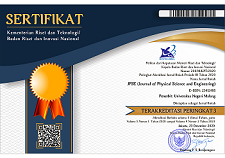A Study on Phase and Microstructure of Reduced Graphene Oxide Prepared by Heating Corncobs
Abstract
The purpose of this study was to find out reduced graphene oxide (RGO) phases by identifying the system, elemental system, and microstructure of corncobs. Characterization was carried out by XRD and SEM-EDX spectroscopy. The temperatures used in this work are 100, 200, and 250 ºC with a holding time of 1 hour. XRD analysis shows that the RGO phase is formed by the structure of the aromatic layer arrangement (graphite 002), and the widening comes from small-dimensional crystallites perpendicular to the aromatic layer (graphite 120). The elements contained in the three samples have a dominant proportion in the elements carbon and oxygen. From the SEM results obtained the morphology of corncobs powder that looks like sheets. The reduced graphene oxide phase is formed from the process of reducing corncobs powder.
Keywords
Full Text:
PDFReferences
Q. Jiang, Z. Zhang, S. Yin, Z. Guo, S. Wang, and C. Feng, “Biomass carbon micro/nano-structures derived from ramie fibers and corncobs as anode materials for lithium-ion and sodium-ion batteries,” Appl. Surf. Sci., vol. 379, pp. 73–82, 2016.
B. Mortazavi, M. E. Madjet, M. Shahrokhi, S. Ahzi, X. Zhuang, and T. Rabczuk, “Nanoporous graphene: a 2D semiconductor with anisotropic mechanical, optical and thermal conduction properties,” Carbon N. Y., vol. 147, pp. 377–384, 2019.
Y. Liu, X. Ge, and J. Li, “Graphene lubrication,” Appl. Mater. Today, vol. 20, p. 100662, 2020.
N. R. Chodankar, A. K. Nanjundan, D. Losic, D. P. Dubal, and J. B. Baek, “Graphene and molybdenum disulphide hybrids for energy applications: an update,” Mater. Today Adv., vol. 6, p. 100053, 2020.
D. Zhang, J. Tong, and B. Xia, “Humidity-sensing properties of chemically reduced graphene oxide/polymer nanocomposite film sensor based on layer-by-layer nano self-assembly,” Sensors Actuators, B Chem., vol. 197, pp. 66–72, 2014.
G. B. A. Putra, H. Y. Pradana, D. E. T. Soenaryo, M. A. Baqiya, and Darminto, “Synthesis of green Fe3+/glucose/rGO electrode for supercapacitor application assisted by chemical exfoliation process from burning coconut shell,” AIP Conf. Proc., vol. 1945, no. 1, p. 020040, 2018.
S. W. Howell et al., “Graphene-insulator-semiconductor junction for hybrid photodetection modalities,” Sci. Rep., vol. 7, no. 1, pp. 1–9, 2017.
K. W. Mas’udah, P. E. Yuwita, A. Taufiq, and Sunaryono, “Fabrication of nanocrystalline carbon based on corncobs charcoal,” AIP Conf. Proc., vol. 2231, no. 1, p. 040020, 2020.
P. E. Yuwita, K. Wardhani, Sunaryono, and A. Taufiq “Investigation of carbon phase structure of corncob charcoal powder investigation of carbon phase structure of corncob charcoal powder,” AIP Conf. Proc., vol. 2231, no. 1, p. 040083, 2020.
K. W. Mas’udah, P. E. Yuwita, Y. A. Haryanto, A. Taufiq, and Sunaryono, “Effect of heat treatment on carbon characteristic from corncob powders prepared by coprecipitation method,” in AIP Conf. Proc., vol. 2251, no. 1, p. 040044, 2020.
S. Saputro, M. Masykuri, L. Mahardiani, and D. Kurniastuti, “The synthesis of corncobs (zea mays) active charcoal and water hyacinth (eichornia crassipes) adsorbent to adsorb Pb(II) with it’s analysis using solid-phase spectrophotometry (sps),” IOP Conf. Ser. Mater. Sci. Eng., vol. 333, no. 1, 2018.
Y. Liu, X. Zhao, J. Li, D. Ma, and R. Han, “Characterization of bio-char from pyrolysis of wheat straw and its evaluation on methylene blue adsorption,” Desalin. Water Treat., vol. 46, no. 1–3, pp. 115–123, 2012.
A. Y. Nugraheni, M. Nashrullah, and F. A. Prasetya, “Study on phase, molecular bonding, and bandgap of reduced graphene oxide prepared by heating coconut shell,” vol. 827, no. 1, pp. 285–289, 2015.
I. Khambali, I. S. Ardiani, A. R. Kurniawan, Triwikantoro, M. Zainuri, and Darminto, “Synthesis of n-doped reduced graphene oxide from coconut shell as supercapacitors,” Mater. Sci. Forum, vol. 966, pp. 437–443, 2019.
H. Ma, J. Li, W. Liu, M. Miao, B. Cheng, and S. Zhu, “Bioresource technology novel synthesis of a versatile magnetic adsorbent derived from corncob for dye removal,” Bioresour. Technol., vol. 190, pp. 13–20, 2015.
K. W. Mas’udah, F. Astuti, and D. Darminto, “Study on physical properties of reduced graphene oxide from heating coconut shell,” JPSE (Journal Phys. Sci. Eng.), vol. 1, no. 1, pp. 1–6, 2016.
Y. Zhang, M. M. Umair, S. Zhang, and B. Tang, “Phase change materials for electron-triggered energy conversion and storage: a review,” Journal of Materials Chemistry A, vol. 7, no. 39, pp. 22218–22228, 2019.
Y. Li et al., “Graphene-CoO/PEG composite phase change materials with enhanced solar-to-thermal energy conversion and storage capacity,” Compos. Sci. Technol., vol. 195, p. 108197, 2020.
A. S. K. Kumar, S. S. Kakan, and N. Rajesh, “A novel amine impregnated graphene oxide adsorbent for the removal of hexavalent chromium,” Chem. Eng. J., vol. 230, pp. 328–337, 2013.
A. S. K. Kumar and N. Rajesh, “Exploring the interesting interaction between graphene oxide, Aliquat-336 (a room temperature ionic liquid) and chromium (VI) for wastewater treatment,” Rsc. Advances, vol. 3, no. 8, pp. 2697–2709, 2013.
Copyright (c) 2020 Kusuma Wardhani Mas'udah, Ahmad Taufiq, Sunaryono

This work is licensed under a Creative Commons Attribution-ShareAlike 4.0 International License.
This work is licensed under a Creative Commons Attribution-ShareAlike 4.0 International License




















